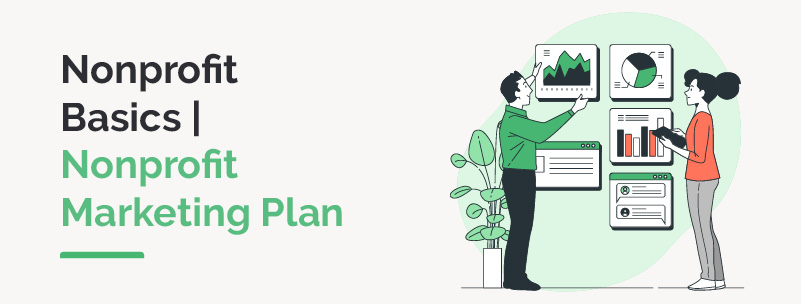Nonprofit Basics: Nonprofit Marketing Plan
While marketing is typically associated with for-profit companies, nonprofits have just as much to gain from having a strong marketing strategy. After all, spreading the word about your cause is essentially marketing your nonprofit as a thought leader and service provider in your community. Marketing also attracts prospective donors and opens the door to developing a relationship with them.
That being said, optimizing your marketing campaign is essential to expand your organization’s reach, and you need a solid plan to do so. Using a nonprofit marketing plan provides a source of truth for your staff and eliminates the guesswork when it comes to executing campaigns. If you’re new to marketing and aren’t sure where to begin, we’ll walk you through the basics of crafting a winning nonprofit marketing plan.
What is a nonprofit marketing plan?
According to Fifty & Fifty, a nonprofit marketing plan is a document that denotes your nonprofit’s marketing and outreach strategies. Your nonprofit marketing plan can encompass a specific campaign or general initiatives to promote your organization and its programs. Whenever you have an idea for a marketing campaign in mind, you should thoroughly plan it out with a nonprofit marketing plan.
What makes nonprofit marketing different from for-profit marketing?
Essentially, marketing for all organizations has a common purpose: attracting attention to your products or services. The main difference for nonprofit marketing is that your marketing should be purely mission-oriented and focus on your charitable activities. A good way to integrate your purpose is by featuring your beneficiaries in your marketing materials and highlighting how the campaign will improve their quality of life.
What are the components of a nonprofit marketing plan?
There are numerous sections that you should include in your nonprofit marketing plan, such as:
Goals
Answer the following questions that help guide your thinking for setting goals:
- What worked in past campaigns? What didn’t?
- What’s our budget?
- What programs/campaigns are we trying to market?
- Which channels do our target audiences prefer?
- How will we brand the campaign?
- Will we work with a nonprofit marketing firm?
Based on your answers to these questions, you can decide which key performance indicators (KPIs) you’ll use to gauge your performance. For instance, your KPIs might be to boost donations or signups for your fundraising event. Ensure you have the infrastructure to track this data so you can determine how successful you were.
Audience research debrief
Effective marketers must have a clear understanding of their target audience’s psyche. In order to analyze your audience’s motivation, priorities, and attitudes, consider conducting audience research. This involves gathering a focus group of people that has similar demographics or interests as your target audience and gauging their responses to your marketing materials. You might use a focus group to decide which branding is more appealing or which communication channel they prefer to use.
If you conduct audience research, include your findings in your nonprofit marketing plan and how the data will impact your strategy.
SWOT analysis
A SWOT, or strengths, weaknesses, opportunities, and threats analysis, is a method of identifying growth opportunities and potential challenges for your nonprofit. Tailor your strategy to complement your strengths and improve upon your weaknesses. Furthermore, identify any marketing opportunities to pursue and threats to prepare for. Outline your findings in your nonprofit marketing plan and how they shape your strategy.
Marketing channels
One of the most important parts of your nonprofit marketing plan is where you delineate which channels you will use to spread your message. You can market your campaign via:
- Direct mail
- Social media
- Texts
- Online ads
- Search engine-optimized content
- Google Ad Grants
- Your website
- Partnerships with related brands or nonprofits
Use your focus group to determine which marketing channels have the most potential for your audience. Then, leverage these channels to engage your supporters and gain more visibility.
Projected timeline
Next, ensure that your nonprofit marketing plan has a calendar for your campaign rollout. Include which channels you’ll use at what time and the frequency of messaging. For example, you might choose to send email appeals out before posting your marketing content on social media. Include your intended dates and be as specific as possible (exact dates are preferable).
Campaign reflection
Once the campaign has finished, your work isn’t done yet! Take time to reflect on your nonprofit marketing efforts and examine if you’ve achieved your goals. Make note of any successful tactics that you’d like to use in the future and which strategies missed the mark. Also, examine if you satisfied your goals by analyzing your KPI data. This will help you set new objectives for the future.
Other Resources to Explore
Nonprofit Basics – Learn more about nonprofit management essentials by exploring other expert resources.
A Guide to Nonprofit Marketing – Learn more about the ins and outs of nonprofit marketing in this ultimate guide.
Nonprofit Marketing Agency: Share Your “Why” – Looking for help launching your marketing efforts? Check out this guide to nonprofit marketing agencies.


